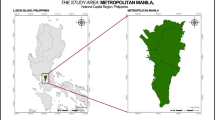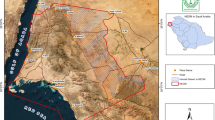Abstract
Many studies are based on the assumption that an area and its surrounding (buffer) area present similar environmental conditions and can be compared. For example, in order to assess the effectiveness of a protected area, the land use/cover changes are compared inside the park with its surroundings. However, the heterogeneity in spatial variables can bias this assessment: we have shown that most of the protected areas in Mexico present significant environmental differences between their interior and their surroundings. Therefore, a comparison that aims at assessing the effectiveness of conservation strategies, must be cautioned. In this paper, a simple method which allows the generation of a buffer area that presents similar conditions with respect to a set of environmental variables is presented. The method was used in order to assess the effectiveness of the Calakmul Biosphere Reserve, a protected area located in the south-eastern part of Mexico. The annual rate of deforestation inside the protected area, the standard buffer area (based upon distance from the protected area only) and the similar buffer area (taking into account distance along with some environmental variables) were 0.3, 1.3 and 0.6%, respectively. These results showed that the protected area was effective in preventing land clearing, but that the comparison with the standard buffer area gave an over-optimistic vision of its effectiveness.
Similar content being viewed by others
References
Apan, A. A. and Peterson, J. A.: 1998, ‘Probing tropical deforestation’, Appl. Geogr. 18(2), 137–152.
Bruner, A. G., Gullison, R. E., Rice, R. E. and da Fonseca, G. A. B.: 2001, ‘Effectiveness of parks in protecting tropical biodiversity’, Science 291, 125–128.
Caro, T. M.: 2001, ‘Species richness and abundance of small mammals inside and outside an African national park’, Biol. Conserv. 98(3), 251–257.
Caro, T. M.: 2003, ‘Umbrella species: Critique and lessons from East Africa’, Animal Conserv. 6(2), 171–181.
CONANP (Comisión Nacional de Áreas Naturales Protegidas): 2003, Retrieved from http://conanp.gob.mx.
East, J. and Wood, M.: 1998, ‘Landcare GIS: Evaluating land management programs in Australia’, Environ. Monit. Assess. 50(3), 201–216.
E1-Raey, M., Fouda, Y. and Gal, P.: 2000, ‘GIS for environmental assessment of the impacts of urban encroachment on rosetta region, Egypt’, Environ. Monit. Assess. 60(2), 217–233.
Groombridge, B. and Jenkins, M. D.: 2000, Global Biodiversity: Earth’s Living Resources in the 21st Century, United Nations Environment Programme (ed.), 246 p.
Ibáñez, R., Condit, R., Angehr, G., Aguilar, S., García, T., Martínez, R., Sanjur, A., Stallard, R., Wright, S. J., Rand, A. S. and Heckadon, S.: 2002, ‘An ecosystem report on the Panama Canal: Monitoring the status of the forest communities and the watershed’, Environ. Monit. Assess. 80(1), 65–95.
Kinnaird, M. F., Sanderson, E. W., O’Brien, T. G., Wibisono, H. T. and Woolmer, G.: 2003, ‘Deforestation trends in a tropical landscape and implications for endangered large mammals’, Conserv. Biol. 17(1), 245–257.
Liu, J., Linderman, M., Ouyang, Z., An, L., Yang, J. and Zhang, H.: 2001, ‘Ecological degradation in protected areas: The case of Wolong nature reserve for giant pandas’, Science 292, 98–101.
Loomis, J. and Echohawk, J. C.: 1999, ‘Using GIS to identify under-represented ecosystems in the National Wilderness Preservation System in the U.S.A.’ Environ. Conserv. 26, 53–58.
Lugo Hubp, J. I.: 1988, Elementos de Geomorfolog’ia Aplicada (Métodos cartográficos), Instituto de Geografía, Universidad Nacional Autónoma de México, México, 128 p.
Margules, C.-R. and Pressey, R.-L.: 2000, ‘Systematic conservation planning’, Nature 405, 243–253.
Mas, J. F. and Puig, H.: 2001, ‘Modalités de la déforestation dans le Sud-ouest de l’Etat du Campeche, Mexique’, Can. J. Forest Res. 31(7), 1280–1288.
Mas, J. F., Velázquez, A., Díaz-Gallegos, J.-R., Mayorga-Saucedo, R., Alcántara, C., Bocco, G., Castro, R., Fernández, T., and Pérez-Vega, A.: 2004, ‘Assessing land use/cover changes: A nationwide multidate spatial database for Mexico’, Int. J. Appl. Earth Observ. Geoinform. 5(4), 249–261.
Ochoa-Gaona, S. and González-Espinosa, M.: 2000, ‘Land use and deforestation in the highlands of Chiapas, Mexico’, Appl. Geog. 20, 17–42.
Ozcan, H., Cetin, M. and Diker, K.: 2003, ‘Monitoring and assessment of land use status by GIS’, Environ. Monit. Assess. 87(1), 33–45.
Pressey, R. L., Whish, G. L., Barret, T. W. and Watts, M. E.: 2002, ‘Effectiveness of protected areas in north-eastern New South Wales: Recent trends in six measures’, Biol. Conserv. 106, 57–169.
Sader, S. A. and Joyce, A. T.: 1988, ‘Deforestation rates and trends in Costa Rica, 1940 to 1983’, Biotropica 20(1), 11–19.
Samways, M. J. and Kreuzinger, K.: 2001, ‘Vegetation, ungulate and grasshopper interactions inside vs. outside an African savanna game park’, Biodivers. Conserv. 10(11), 1963–1981.
Sánchez-Azofeifa, G. A., Quesada-Mateo, C., Gonzalez-Quesada, P., Dayanandan, S. and Kamaljit S. B.: 1999, ‘Protected areas and conservation of biodiversity in the tropics’, Conserv. Biol. 13(2), 407–411.
Sánchez-Azofeifaa, G. A., Dailyb, G. C., Pfaffc, A. S. P. and Buschd, C. C.: 2003, ‘Integrity and isolation of Costa Rica’s national parks and biological reserves: Examining the dynamics of land-cover change’, Biol. Conserv. 109(1), 123–l35.
Soares-Filho, B., Assunção, R. M. and Pantuzzo, A. E.: 2001, ‘Modeling the spatial transition probabilities of landscape dynamics in an Amazonian colonization frontier’, BioScience 51(12), 1059–1066.
Vanclay, J. R.: 2001, ‘The effectiveness of parks’, Science 293, 1007a.
Wood, A., Stedman-Edwards, P. and Mang, J.: 2000, The Root Causes of Biodiversity Loss, Earthscan Publications Ltd., U.K., 399 p.
Author information
Authors and Affiliations
Corresponding author
Rights and permissions
About this article
Cite this article
Mas, JF. Assessing protected area effectiveness using surrounding (buffer) areas environmentally similar to the target area. Environ Monit Assess 105, 69–80 (2005). https://doi.org/10.1007/s10661-005-3156-5
Received:
Accepted:
Issue Date:
DOI: https://doi.org/10.1007/s10661-005-3156-5




